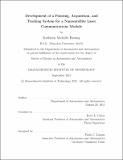Development of a pointing, acquisition, and tracking system for a nanosatellite laser communications module
Author(s)
Riesing, Kathleen Michelle
DownloadFull printable version (17.17Mb)
Other Contributors
Massachusetts Institute of Technology. Department of Aeronautics and Astronautics.
Advisor
Kerri L. Cahoy.
Terms of use
Metadata
Show full item recordAbstract
Launch opportunities for small satellites are rapidly growing and their technical capabilities are improving. Several commercial constellations of small satellites for Earth imaging and scientific observation are making their way onto orbit, increasing the need for high bandwidth data downlink. Obtaining regulatory licensing for current radio frequency (RF) communications systems is difficult, and state of the art nanosatellite RF systems struggle to keep up with the higher demand. Laser communications (lasercom) has the potential to achieve high bandwidth with a reduction in power and size compared to RF, while simultaneously avoiding the significant regulatory burden of RF spectrum allocation. Due to narrow beamwidths, the primary challenge of lasercom is the high-precision pointing required to align the transmitter and receiver. While lasercom has been successfully demonstrated on multiple spacecraft platforms, it has not yet been demonstrated on a scale small enough to meet the size, weight, and power constraints for nanosatellites. The Nanosatellite Optical Downlink Experiment (NODE) developed at MIT is designed to achieve a lasercom downlink of 10 to 100 Mbps within the constraints of a typical 3-U CubeSat. This thesis focuses on the development of the pointing, acquisition, and tracking system for NODE. The key to achieving a high bandwidth downlink is to bridge the gap between existing CubeSat attitude determination and control capabilities and the narrow beamwidths of lasercom. We present a two-stage pointing control system to achieve this. An uplink beacon and detector provide fine attitude feedback to enable precision pointing, and CubeSat body pointing is augmented with a fine steering mechanism. The architecture of the pointing, acquisition, and tracking system is presented, followed by the in-depth design and hardware selection. A detailed simulation of the ground tracking performance is developed, including novel on-orbit calibration algorithms to eliminate misalignment between the transmitter and receiver. A testbed is developed to characterize the selected fine steering mechanism for performance and thermal stability. The proposed system is capable of achieving at least two orders of magnitude better pointing than existing CubeSats to enable high bandwidth nanosatellite downlinks.
Description
Thesis: S.M., Massachusetts Institute of Technology, Department of Aeronautics and Astronautics, 2015. This electronic version was submitted by the student author. The certified thesis is available in the Institute Archives and Special Collections. Cataloged from student-submitted PDF version of thesis. Includes bibliographical references (pages 121-127).
Date issued
2015Department
Massachusetts Institute of Technology. Department of Aeronautics and AstronauticsPublisher
Massachusetts Institute of Technology
Keywords
Aeronautics and Astronautics.